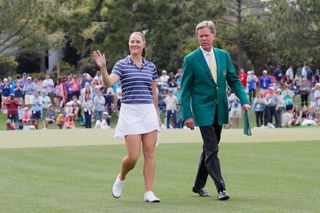The R&A Proposes Changes To Golf’s Rules of Amateur Status
We assess and discuss the just-announced proposed changes to golf's Rules of Amateur Status with director of Rules at The R&A, Grant Moir


We assess and discuss the just-announced proposed changes to golf's Rules of Amateur Status with director of Rules at The R&A, Grant Moir
The R&A Proposes Changes To Golf’s Rules of Amateur Status
The R&A and the USGA have today announced proposals for significant changes to the Rules of Amateur Status. The changes form part of an ongoing modernisation initiative to ensure that the Rules better reflect today’s global amateur game.
As with the 2019 modernisation of the playing Rules, the goal has been to make all aspects of these Rules easier to understand and apply.
Why now?
"Our view was that golf doesn’t stand still. It continues to evolve and modernise and we feel that the Rules have to do the same thing," Grant Moir, director of Rules at The R&A told us.

"We want to make the Rules easier to understand and apply. The key point is that we believe these proposals are good for amateur golf as a whole. But in particular, there’s a need to address the challenges elite amateur golfers face in funding their way through the elite amateur game."
Get the Golf Monthly Newsletter
Subscribe to the Golf Monthly newsletter to stay up to date with all the latest tour news, equipment news, reviews, head-to-heads and buyer’s guides from our team of experienced experts.
The review of golf's Rules of Amateur Status, which began in late 2017, reaffirms the important position that amateur golf continues to play. It seeks to redefine the distinction between amateur and professional golf with a streamlined condition of eligibility (amateur status).
What's changing?
If the proposed changes go ahead as planned, only three things would cause a golfer to relinquish amateur status in future. These are:
- Accepting a prize in excess of the prize limit (currently $750).
- Accepting payment for giving instruction.
- Accepting employment as a golf club professional or membership of an association of professional golfers.
Achieving this simplified approach would entail the following:
- Eliminating the distinction between cash prizes and other prizes.
- Using the prize limit as the only way an amateur can lose amateur status through their play. Entering or playing a competition as a professional would not, of itself, result in the loss of amateur status.
- Removing restrictions from the Rules surrounding competitions such as long-drive events, putting competitions and skills competitions that are not played as part of a tee-to-hole competition; and
- Eliminating all sponsorship restrictions.
The rationale for change
"Ultimately, we felt that continuing to have restrictions on prize levels was appropriate," Moir told us on the issue of maximum amateur prize money, while explaining that there would no longer be a distinction between cash prizes and other prizes.
"These Rules have served us well in keeping thing in check and will continue to do so in the future. There was no big push to go for unlimited prizes in handicap amateur golf or even elite amateur golf. We continue to feel that having restrictions serves the game as a whole well.”

"There’s certainly more scope now for amateurs to have arrangements," Moir said on the theme of sponsorship, "whether with an equipment supplier or local business from whom they can receive help. They would be in a position under the new Rules to now advertise the source of that help.
"Getting support has been possible for a long period of time. But it had to go through a more formal process and they weren’t able to acknowledge the source. This inevitably made it harder for them to get that support!
"Now the proposal to lift those restrictions will make it a much easier two-way process."
Why keep the Rule of Amateur Status?
Given all this, are the Rules of Amateur Status really still required in today’s era of the increasingly ‘professionalised’ elite amateur game?
"That was the fundamental question we asked ourselves at the outset and we felt it a good and important question," Moir confirmed. "But when we drilled down into it, we felt that the Rules of Amateur Status still have their place.

A self-regulating game
"The game prides itself on being self-regulating. It relies on integrity. We didn’t want to introduce any unnecessary or additional pressures on the self-regulating nature of the game in the Rules of Golf and the Rules of Handicapping."
Indeed. Nobody wants higher-value prizes to prove too tempting a proposition for the hopefully tiny minority of club golfers who might be led astray.
"In addition to that, the elite amateur competitions that have been with us for a long time continue to provide a clear and well-trodden pathway for amateurs looking to progress into the professional ranks," Moir said in summary.
"We feel these events have served us well and don’t want to jeopardise that. We think that having a distinction between amateurs and non-amateurs continues to be relevant. But we are looking to soften the distinction in some areas."
The plan is to adopt the proposed changes to the Rules of Amateur Status on January 1, 2022. First, though, there will be a period of feedback from golfing organisations and stakeholders. Comments on the proposed changes will be accepted up until March 26, 2021.

Jeremy Ellwood has worked in the golf industry since 1993 and for Golf Monthly since 2002 when he started out as equipment editor. He is now a freelance journalist writing mainly for Golf Monthly. He is an expert on the Rules of Golf having qualified through an R&A course to become a golf referee. He is a senior panelist for Golf Monthly's Top 100 UK & Ireland Course Rankings and has played all of the Top 100 plus 91 of the Next 100, making him well-qualified when it comes to assessing and comparing our premier golf courses. He has now played 1,000 golf courses worldwide in 35 countries, from the humblest of nine-holers in the Scottish Highlands to the very grandest of international golf resorts. He reached the 1,000 mark on his 60th birthday in October 2023 on Vale do Lobo's Ocean course. Put him on a links course anywhere and he will be blissfully content.
Jezz can be contacted via Twitter - @JezzEllwoodGolf
Jeremy is currently playing...
Driver: Ping G425 LST 10.5˚ (draw setting), Mitsubishi Tensei AV Orange 55 S shaft
3 wood: Srixon ZX, EvenFlow Riptide 6.0 S 50g shaft
Hybrid: Ping G425 17˚, Mitsubishi Tensei CK Pro Orange 80 S shaft
Irons 3- to 8-iron: Ping i525, True Temper Dynamic Gold 105 R300 shafts
Irons 9-iron and PW: Honma TWorld TW747Vx, Nippon NS Pro regular shaft
Wedges: Ping Glide 4.0 50˚ and 54˚, 12˚ bounce, True Temper Dynamic Gold 105 R300 shafts
Putter: Kramski HPP 325
Ball: Any premium ball I can find in a charity shop or similar (or out on the course!)
-
 How To Watch The Players Championship: Live Streams, TV Channels, Schedule
How To Watch The Players Championship: Live Streams, TV Channels, ScheduleThis year will be the sixth running of the event, with 23 nationalities competing and with the final round played around Augusta National's iconic course.
By Roderick Easdale Published
-
 Sun Day Red Launches Azalea Gold Collection, And It Might Be The Best 'Augusta-Themed' Range We Have Seen
Sun Day Red Launches Azalea Gold Collection, And It Might Be The Best 'Augusta-Themed' Range We Have SeenTiger Woods' brand has just released the new collection and we are big fans already...
By Sam Tremlett Published